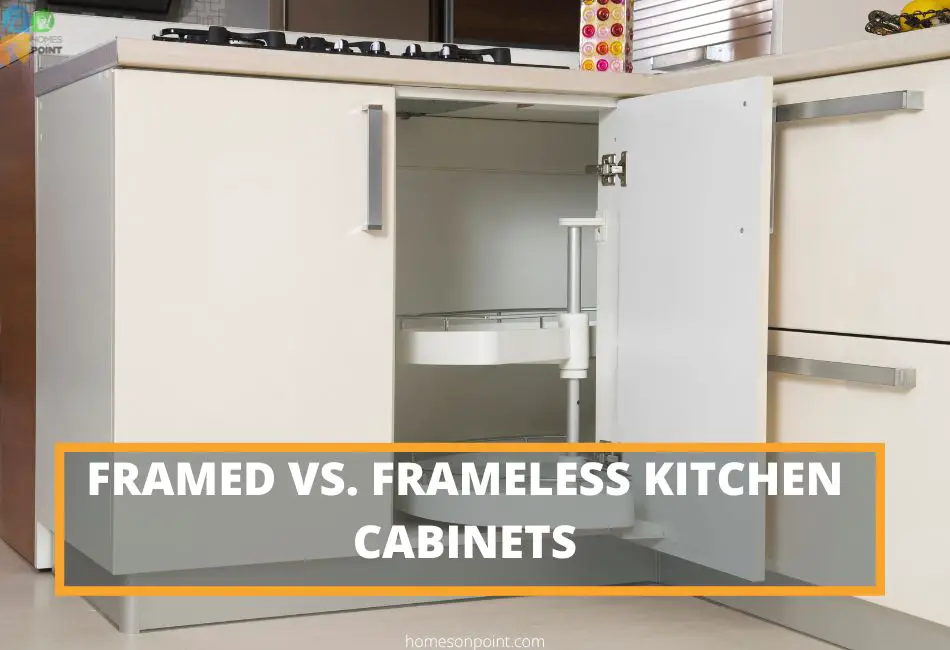I wish choosing kitchen cabinets did not involve that much work. However, considering that those storage units cost a large chunk of the entire kitchen budget, it goes beyond choosing them based on how they look. One intricate decision you will have to make is whether to get framed or frameless kitchen cabinets.
These two styles of cabinetry offer the same storage function but are slightly different beyond that. Framed and frameless cabinets largely differ in the way they are constructed. This construction has a direct reflection on how many items each cabinet can hold.
In this article, I will delve deeper into what both styles of cabinetry are, how similar they can be, and how they differ. All you need to know about framed and frameless cabinets is right here.
What Is A Framed Cabinet?
A framed cabinet has a structure that has been laid over the original structure of the cabinet. This structure or frame consists of two vertical pieces called stiles and two horizontal pieces called rails. Framed cabinets mimic a picture frame.
If these framed cabinets come with doors, their hinges are fitted on the frame. On the other hand, if the cabinet will take drawers, they will rest on the frame. The supporting frames of framed cabinets lend a bit of extra strength to the cabinet.
Framed cabinets used to be the commoner style of cabinetry and it offers a classic traditional feel. Framed cabinets, referred to as the American style of cabinetry, are also known as face-framed cabinets
What Is A Frameless Cabinet?
If a cabinet has no frame laid on the cabinet structure, it is a frameless cabinet. Every cabinet is frameless until the frames are installed. Originally European-inspired, frameless cabinets do not give up any internal portions of the cabinets for frames.
Frameless cabinets are more versatile and contemporary as they can be used in a traditional or modern kitchen. Another name for frameless cabinets is full-access cabinets. Frameless cabinets are sleek and allow the user to maximize the interior of the cabinets. They are however more difficult to install.
Framed Vs Frameless Kitchen Cabinets: Similarities And Differences
As I stated earlier, framed and framed cabinets are two different styles of cabinetry. Their similarities lie in their function but they are differentiated mostly by the way they look and how they are installed.
Similarities In Framed And Frameless Cabinets
- Both Come In Similar Sizes
Both framed and frameless kitchen cabinets are storage units that can be found in similar dimensions and take both doors and drawers. Though the frame can take away from the internal dimensions of framed cabinets, both cabinet styles measure the same on the outer dimensions.
- Both Are Equally Priced
When it comes to cost, framed and frameless cabinets are about the same prices. While one may be slightly more expensive than the other, for the most part, they cost the same. The discrepancies depend on the manufacturer and material used.
- Both Are Durable
Gone are the days when framed cabinets were considered more durable than frameless ones. Now, I can say manufacturers of frameless cabinets have upped their game, making them as equally durable as the framed ones.
Differences In Framed And Frameless Cabinets
- The Frame
The main difference between framed and frameless kitchen cabinets is the frame as it is what affects every other difference that may arise. While in the frameless cabinet there is no face frame, framed cabinets have a frame laid over the cabinet structure itself.
- Installation Of Cabinet Door Hinges
In framed cabinets, the doors and drawers rest on the frame. The hinges of cabinet doors are therefore installed on the frame. Conversely, frameless cabinet doors are hinged on the cabinet structure itself.
- Storage Optimization
Though marginal, frameless cabinets give maximization of storage space because there is no frame to eat into the internal dimensions of the cabinet. Framed cabinets do not allow you to maximize your storage space as a bit of the internal dimensions is occupied by the frame.
Pros And Cons Of Framed Cabinets
Pros
- Framed Cabinets Are Easy To Install
Framed cabinets are comparatively easier to install. The frame serves as a sort of guideline for fixing the hinges for the cabinet doors as well. Therefore, it makes it easier to have straight and aligned cabinet doors and drawers.
- Framed Cabinets Come In Varied Material Options
With framed cabinets, they are made from various materials including solid wood, medium-density fibreboard (MDF), particle board, and laminate. As a buyer, it gives you a wide range to choose from to suit your needs, budget, and/or style.
- Framed Cabinets Are Sturdier
The face frame of framed kitchen cabinets lends some more support and strength to the entire cabinet. This however does not mean frameless cabinets are not durable. Nowadays, manufacturers of frameless cabinets are also at par when it comes to durability.
Cons
- Framed Cabinets Have Less Storage Space
Though the storage space that is taken away in framed cabinets may be considered minimal, sometimes even less than 2 inches, it still counts. Framed cabinets take away from your potential storage space because of the space taken by the frame placed over the cabinet structure.
- Framed Cabinets Are Difficult To Customize
Though easy to install, framed cabinets are difficult to customize once fitted. The frames somewhat restrict your choices of cabinet doors and drawer styles.
- Framed Cabinets Need Extra Work For Finishing Touches
Because framed cabinets do not give a sleek look like frameless ones, you will need extra panels to cover the exposed portions of the frame. This is in a bid to flush the exposed seams so they can have a neater finish.
Pros And Cons Of Frameless Cabinets
Pros
- Frameless Cabinets Have A Sleek Look
Comparatively, frameless kitchen cabinets give a cleaner contemporary look than their framed counterparts. Because the sides of the cabinets flush with the cabinet doors and drawers, leaving no seams, frameless cabinets give a sleek look.
- Frameless Cabinets Give More Storage Space
I know you may think it is just a few inches, however, for someone will a lot of things to put in storage, it counts that frameless cabinets give more storage space. Due to the absence of a frame, there is no stealing of cabinet space.
- Frameless Cabinets Are Easy To Clean
Cleaning frameless cabinets are easy because there are no tight corners and seams you need to reach to pick out dirt. Just by opening your cabinet door or pulling out your drawer, you can use simple cleaning equipment and be done in no time.
Cons
- Frameless Cabinets Offer Limited Material Options
Frameless cabinets are made from medium-density fiberboard (MDF), particleboard, or plywood. Unlike in framed cabinets, there are not many options to choose from. Buyers are therefore restricted in this section.
- Frameless Cabinets Are Less Sturdy
While I have already pinpointed that frameless cabinets can be as durable as framed ones, comparatively, frameless cabinets are less durable.
Because of the absence of a frame, which is supposed to give a bit of extra strength to the cabinet, unless constructed well, frameless cabinets are less sturdy.
Again, the hinges are fitted on MDF as opposed to frames so this may result in racking, a term used to describe the misalignment of cabinet doors and drawers.
Are Frameless Cabinets More Expensive Than Framed?
The difference in price between framed and frameless cabinets is marginal. Frameless cabinets, in most cases, are slightly more expensive than framed ones. It is however safe to say frameless and framed cabinets are mostly priced equally.
The difference in the price of frameless and framed cabinets is mostly based on the type of material used in making them. Until recently, most manufacturers of framed cabinets used thinner materials for the cabinets, resulting in a lower production cost and selling price.
However, that’s not the case anymore so I can tell you that frameless and framed cabinets are about the same prices. So, if there is the perception that frameless cabinets are more expensive, it is not entirely true.
Which One Is Right For You?
Considering the pros and cons of both cabinetry designs, the one that is right for you will be based on which one you prefer, how much you are willing to spend, and your personal storage needs.
If you are going for a contemporary look to match your kitchen style and at the same time allow you to maximize your storage space, then your pick should be frameless cabinets.
On the other hand, if you want a more traditional look and would sacrifice a bit of your storage space, you can opt for framed kitchen cabinets.
Conclusion
Beyond the aesthetic of cabinets, you will need to decide whether you prefer framed or frameless kitchen cabinets.
With frameless cabinets, there is no face frame laid over the cabinet structure, allowing you to optimize the use of your storage space. They also offer a modern sleek look and are easy to clean though difficult to install.
Framed cabinets, on the other hand, have a frame over the cabinet structure that steals a bit from the storage space. They are however easy to install but comparatively difficult to clean.


